Ever since arriving back in Denmark after my Scotland adventure and knowing that I’d be stuck here for quite a while due to Covid-19, I had been playing with the idea of exploring my home municipality of Odder in a slightly different way than usual. I’d recently discovered a nice little walk in the town of Odder, which follows the stream of the same name, and I thought to myself how fun and challenging it might be to follow the entire stream from start to finish.
I had three days off work two weeks ago and decided to make that idea become a reality, only I would begin my trek at the mouth of the stream rather than where it begins, since it’s always easier to find the spot where the stream flows into a larger body of water rather than where it has its spring – which in this case is in the middle of nowhere.
The stream that I’d decided to follow is Odder Å, which has its spring near Oldrup, flows through the town centre of Odder, confluences with Rævs Å near Assedrup and flows into Norsminde Fjord, which again flows into the Kattegat Sea. There are only a few sections with footpaths; the rest would be off-trail, and I was going to try my best to do it without trespassing.
I packed my camping gear in a huge backpack and set off shortly before midday. My original plan was to spend three days trekking, starting from Norsminde Harbour, following the stream to its end near Oldrup and then hiking along the road to Amstrup on the opposite coast, a total of 35 km if following the stream did not require any detours. Well, it did. It required a lot of detours and also a lot more energy than expected, so I never actually made it to Amstrup, but I did complete the entire length of the stream which ended up being just over 30 km including detours.
From Norsminde Harbour to the fjord

My dad drove me to Norsminde Harbour, where I began my trek at 11.15 AM. The first leg of my trip involved making my way along the north shore of Norsminde Fjord to the mouth of the stream on the west side of the fjord.
But first, I wanted to explore Norsminde a little; I wanted to see the ruins of the old Kysing Church, located on top of a hill behind the local inn. The church was first mentioned in 1315 and was in use for at least 400 years until it was demolished or left to decay. The reuse of rocks from ancient monuments was common in the 18th-19th century, but thankfully, the remains of the church ruins were saved from total destruction in 1875, when the owners of the inn decided to convert the site into a memorial of the Second Schleswig War in 1864 by placing a bust of King Frederik 7 on top of the ruin.


After my little history detour, I made my way down to the fjord and began my trek along its north shore. The fjord is only three kilometres long, but it took me no less than THREE HOURS to complete this leg of the trek!
I was met with my first challenge almost immediately as I had to go through endless amounts of reed beds (with sooo many cobwebs!). When I finally got to an open area, I realized that I was going to enter a private garden if I continued walking along the shore. I’d promised myself not to trespass, so instead of continuing along the shore, I made a detour through a forest and onto the road. I then followed the edge of a field until I got to a dirt road that took me past a house and back down to the shore. The detour paid off as I got a great panorama of the fjord as I made my way back down.
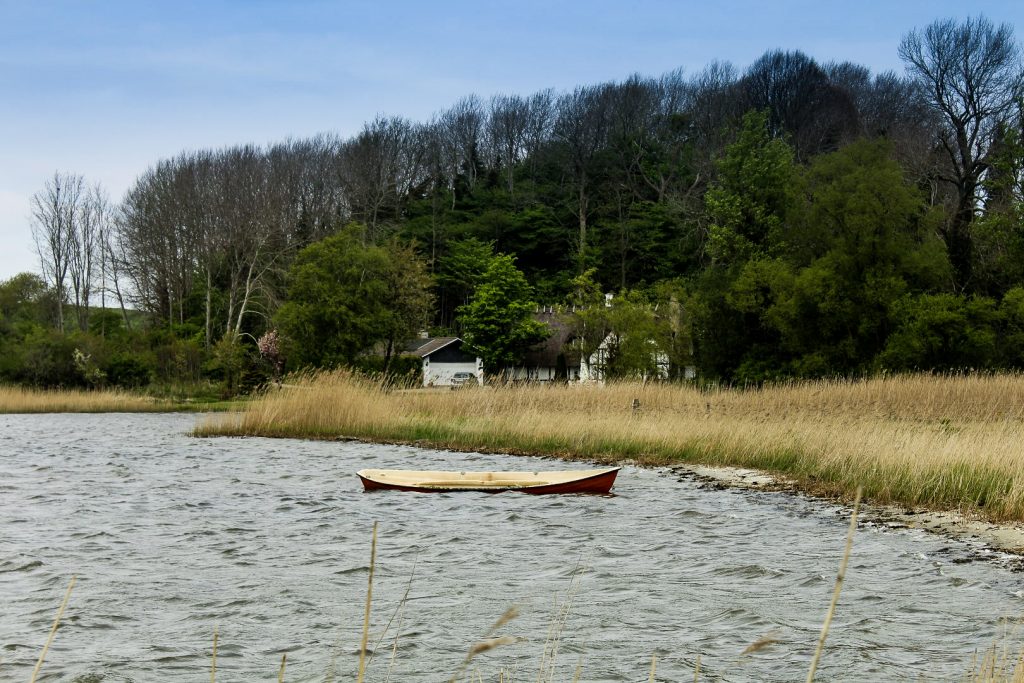



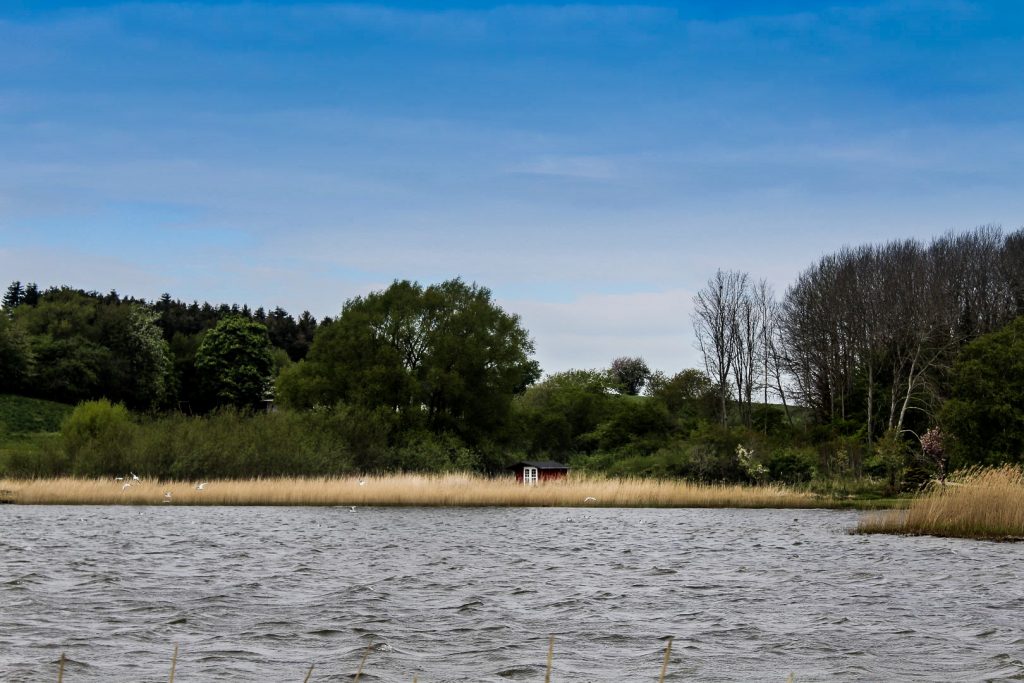
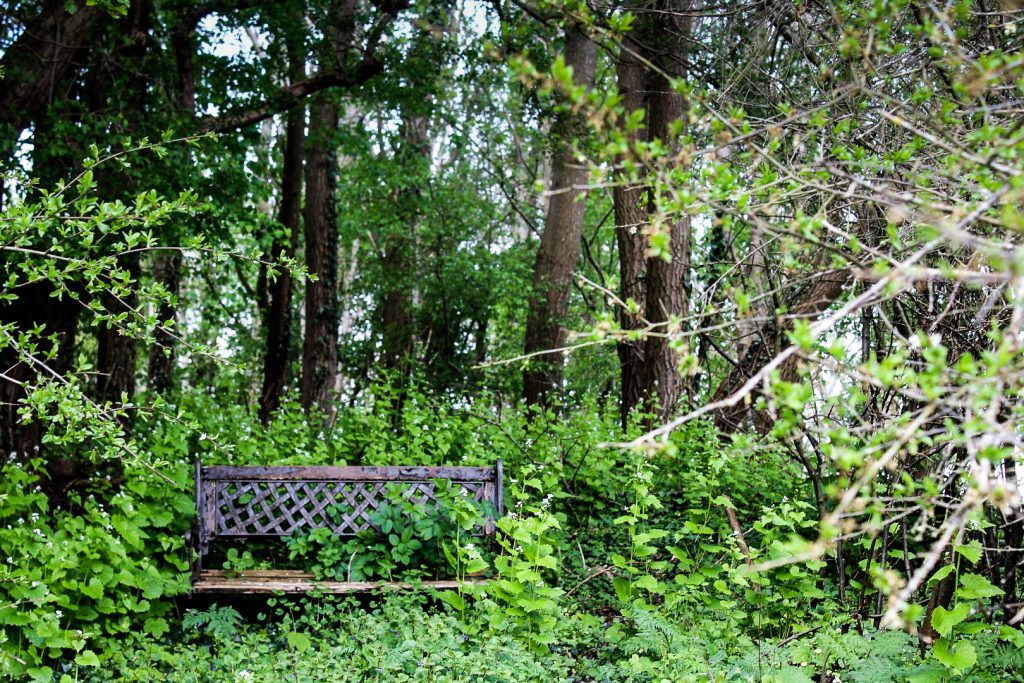
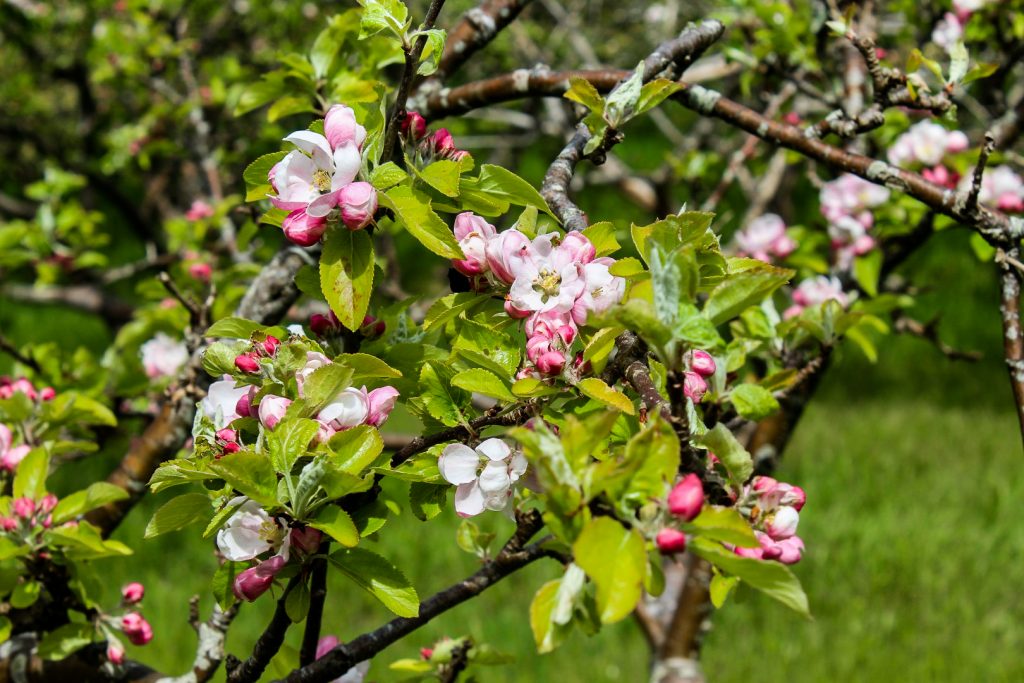
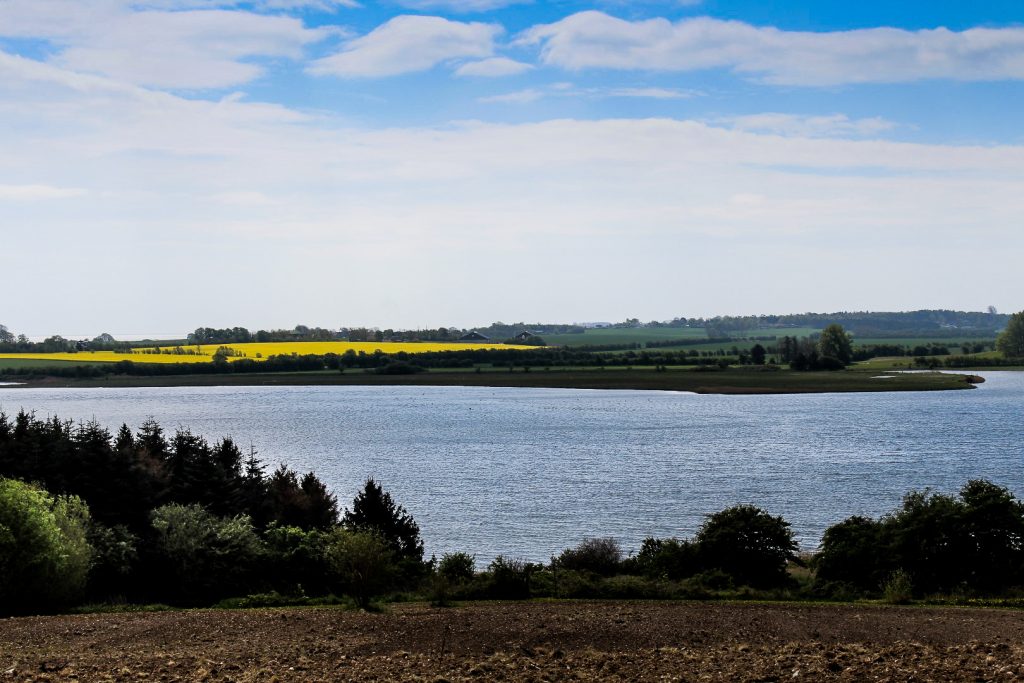

What I didn’t realize until after my trek was that the north shore of the fjord is privately owned, unlike the majority of the south shore. I actually hadn’t even considered the south shore as the north route seemed so logical to me, especially since I know the area quite well (apart from the reed beds…) due to various archaeological field trips to the area. Because of my detour, I actually ended up at the famous Norsminde kitchen midden, a waste area which revealed a skeleton of a young female from the Late Ertebølle period (4357-4249 BC), a site which I’d previously surveyed and since forgotten the exact location of.
Apart from the garden that I avoided, I didn’t realize that the north shore was privately owned as there were no signposts or fences, so I continued my walk in oblivion.
I was met with more reed beds as well as stinging nettles and immediately regretted not taking a longer detour past the reed beds. I fought my way through, and eventually, I got to a welcome beachy section of the shore.
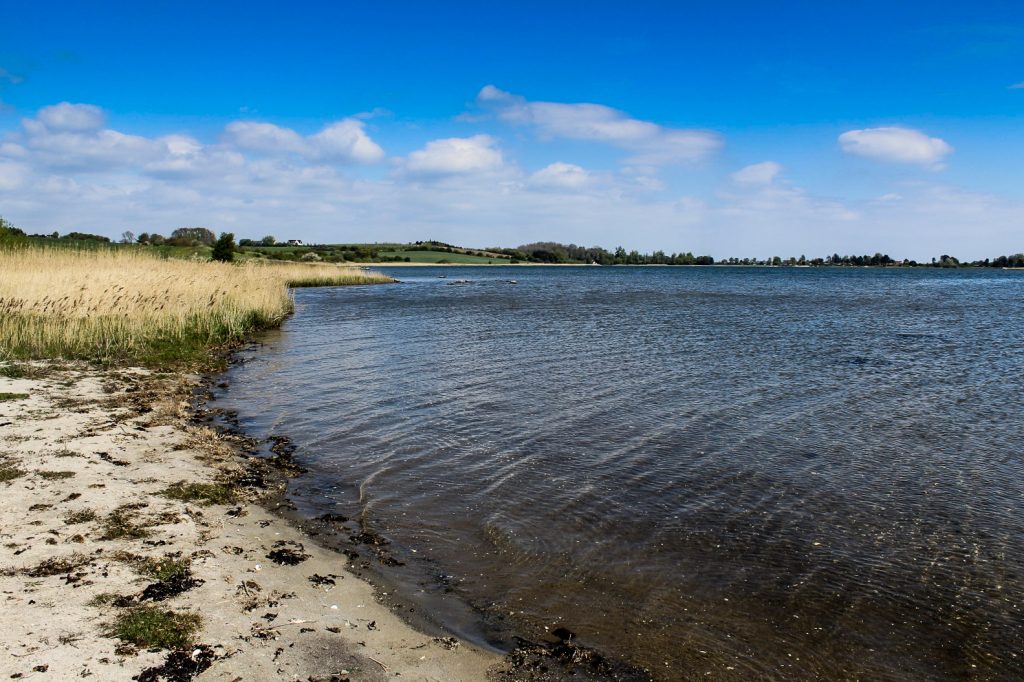

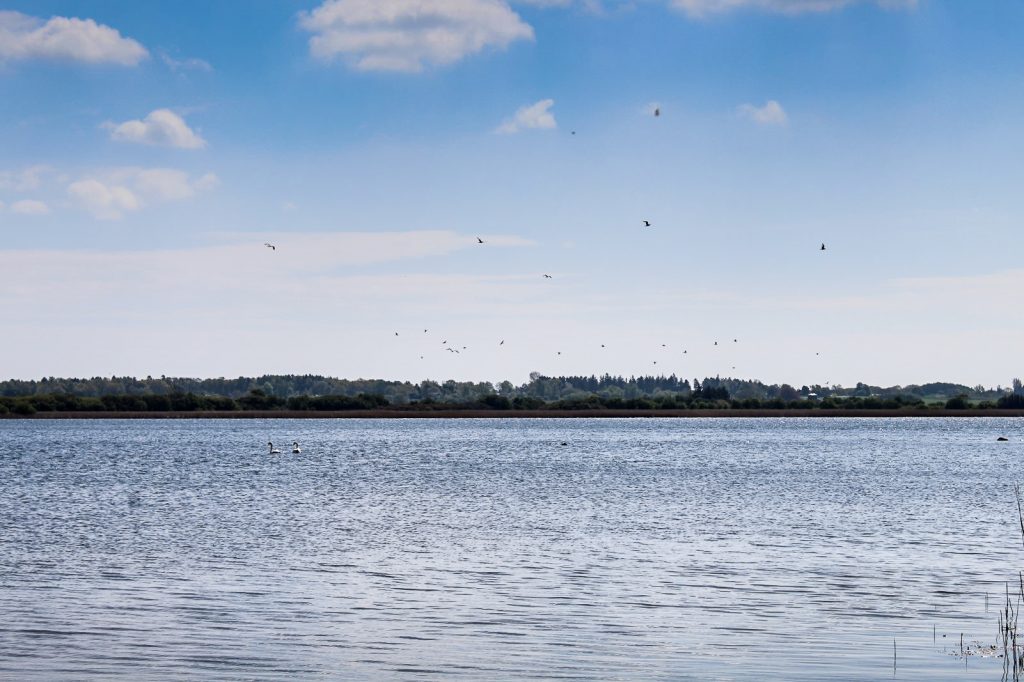
Walking along this section of beachy shores allowed me to fully enjoy the sounds of nature. The fjord is a wilderness preserve with special focus on the swan and other birds, especially migratory birds, many of which I spotted. This was by far the most enjoyable section of the trek, since the terrain was easy and the nature gorgeous. Unfortunately, it was a rather short section…
Finding the mouth of Odder Å/Rævs Å

The shores of Norsminde Fjord, particularly the north shore, is full of remnants of the Late Mesolithic population that called the area home. Shell middens are scattered along the fjord and some of them have provided unique finds. The Flynderhage kitchen midden is the most well known in the area as it revealed a rare ornamented paddle blade from the same period as the skeleton mentioned above. I’ve been to Flynderhage before to do a small survey, and I was excited to experience the area again.
Unfortunately, I never got to Flynderhage.
I was walking along the shore, enjoying the silence when it was suddenly broken by three gunshots. I was headed towards a forest and I didn’t feel safe going there knowing that there were hunters in the area, but there was a huge farm behind me so I couldn’t go that way. I decided to walk to the forest and when I got there, I hadn’t heard any gunshots in a while so I figured they were done. But then I spotted 4-5 deer and minutes later, another shot was fired. It was too dangerous to continue into the forest so I made a long detour, walking along the edge of the forest, through more reed beds and stinging nettles (which easily went through my leggings…) until I got to a dirt road that lead me to the tiny village of Synnedrup.
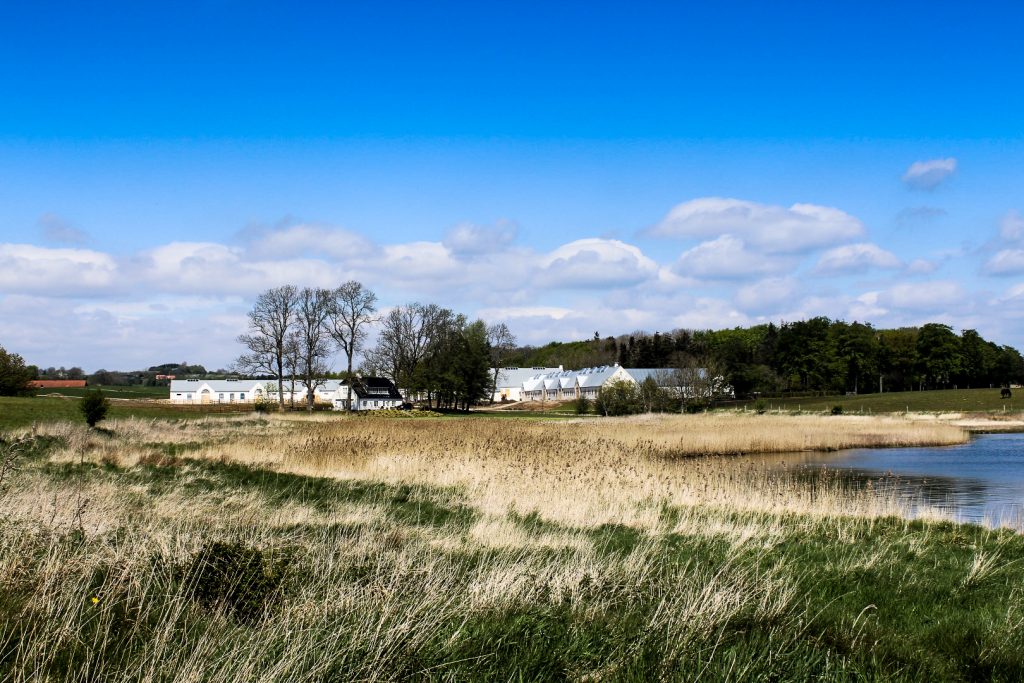


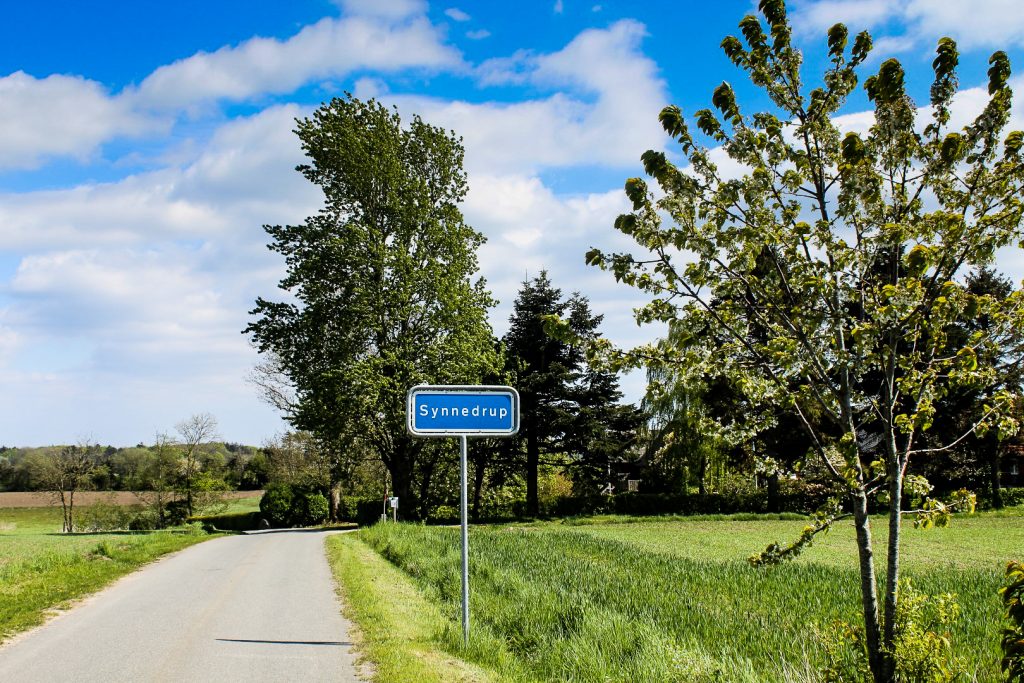
I was happy to have escaped the forest, and walking along a paved road was a welcome change to the difficult terrain of the fjord shore. It didn’t last long though as I had to find my way back to the fjord so I could locate the mouth of Rævs Å, the stream that Odder Å flows into. I walked down another dirt road that brought me to a secluded house above the meadow west of the fjord. Luckily, nobody saw me as I snuck along the edge of a field and down to the meadow, where I found Rævs Å.
My detour had brought me beyond the mouth of the stream, so I had to backtrack a few hundred meters to find it. When I finally did, I was overjoyed. The first leg of my trek was complete!
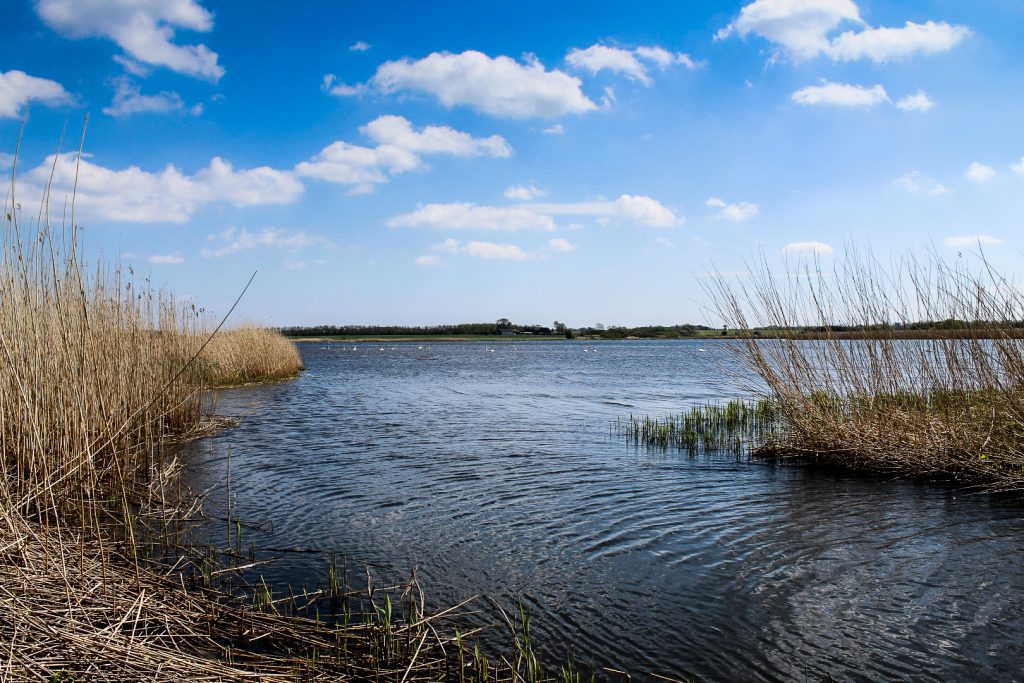
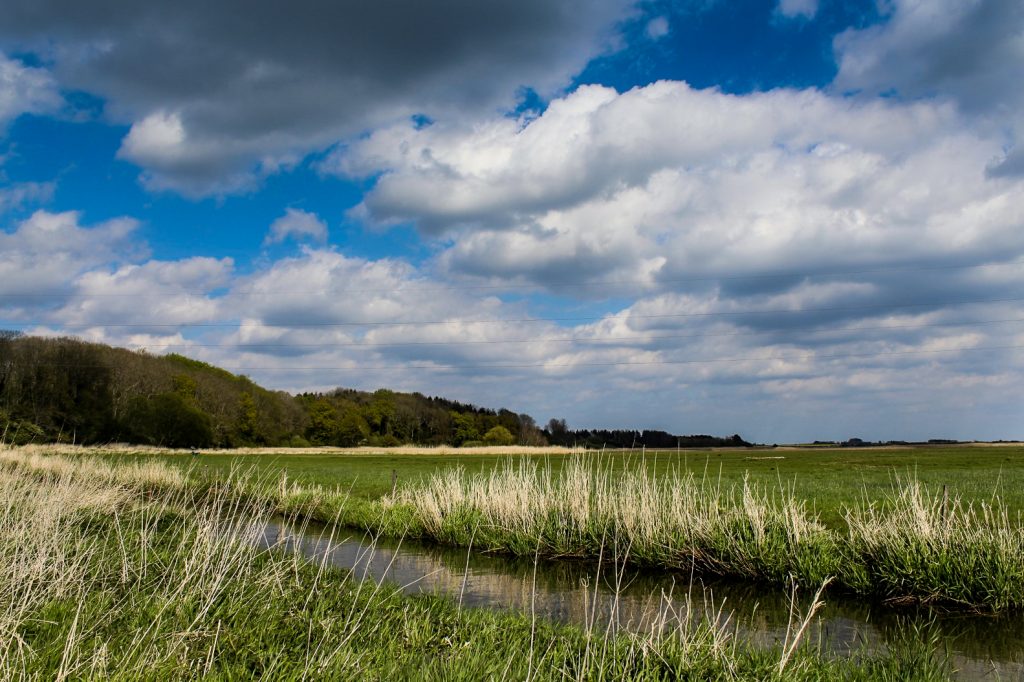
The time was now 2.15 PM. It had taken me three hours to complete this very short section, which was mainly due to tough terrain and long detours. At this point, I realized that I wouldn’t make it to Amstrup after all. I didn’t know what kind of terrain I would be met with later on in the day, but I wasn’t expecting it to be any easier.
Through fields to Assedrup

I was excited to finally begin the second leg of the trek, but I was getting hungry so I needed to find a spot for a lunch break first. I fought my way through more reed beds before finally finding an open spot with a perfect view of the stream. Sitting down was much needed, and so was the food I ate, although I didn’t have the appetite for lots of it. I had definitely brought way too much food with me.
It was past 3 PM when I started walking again. I was thrilled to see the end of the reed beds and the beginning of a long section of mostly dry meadow. Unfortunately, I soon had grazing lands on both sides of the stream, both with an electric fence, so I had to keep as close to the stream as possible in order to not trespass or get an electric shock. In some places, the fence came right to the bank of the stream, so I had to crawl under it, and I did get electric shocks quite a few times.
At one point, when I was crawling beneath the fence, a cow started running towards me. I quickly pulled myself back and stood up on the narrow piece of land between the stream and the fence as I watched him come closer, then stop to investigate and then run away as fast as he could. I guess he thought I was a bit scary-looking with my backpack!

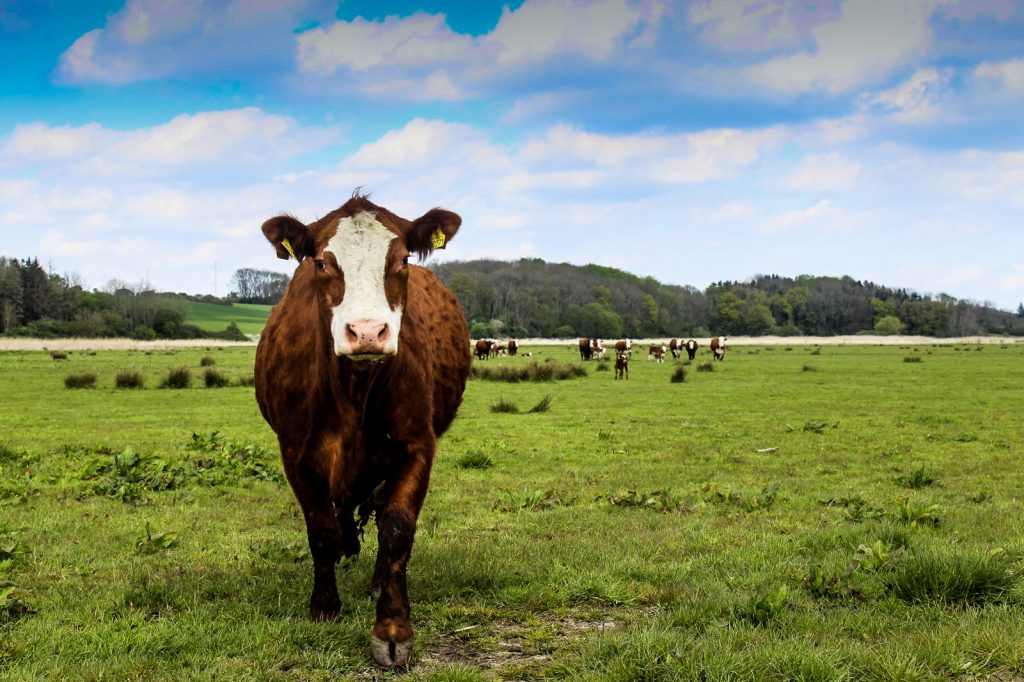
The next challenge came shortly after as I had to cross a brook that flows into the stream. It was only just too wide for me to step over it, and I wasn’t about to try jumping with a heavy backpack and my camera around my neck!
So I decided to take my shoes and socks off, and then walk across the brook while carrying my backpack and camera. It worked surprisingly well and only my leggings got wet, but they dried quickly in the sun. However, I landed in a bunch of stinging nettles and got stung all over my body… Not fun!
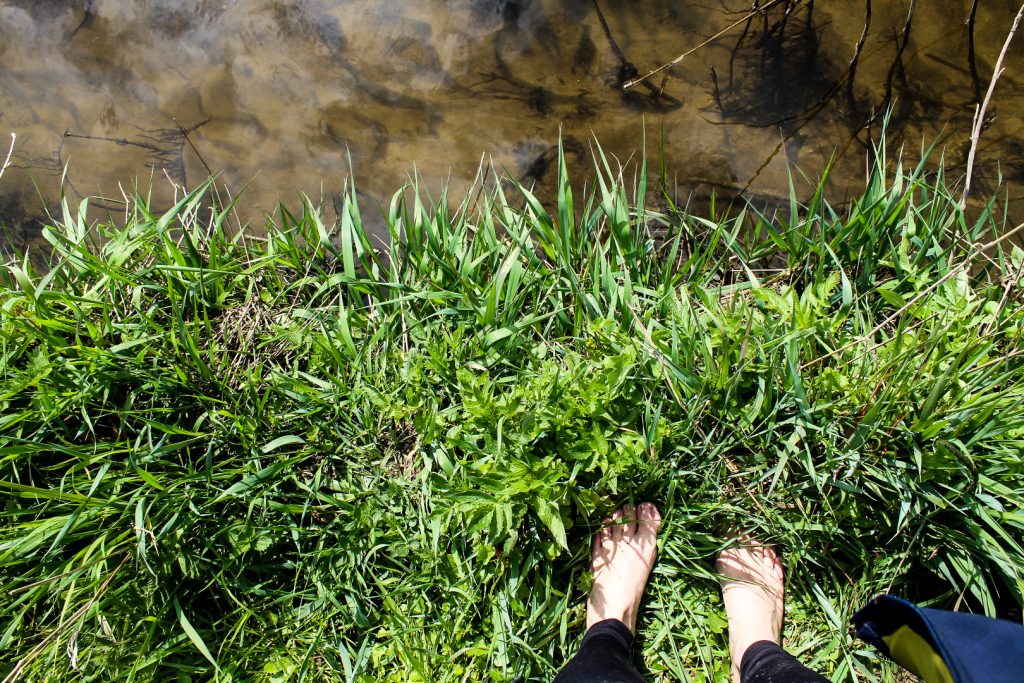

I was almost in the village of Assedrup when I spotted a farmer across the grazing field that I was on, but i just kept walking and thankfully, he didn’t take any notice. I tried my hardest to stay behind the fence but in some places there was no space left to walk so it was either crawl beneath the fence or fall into the stream.

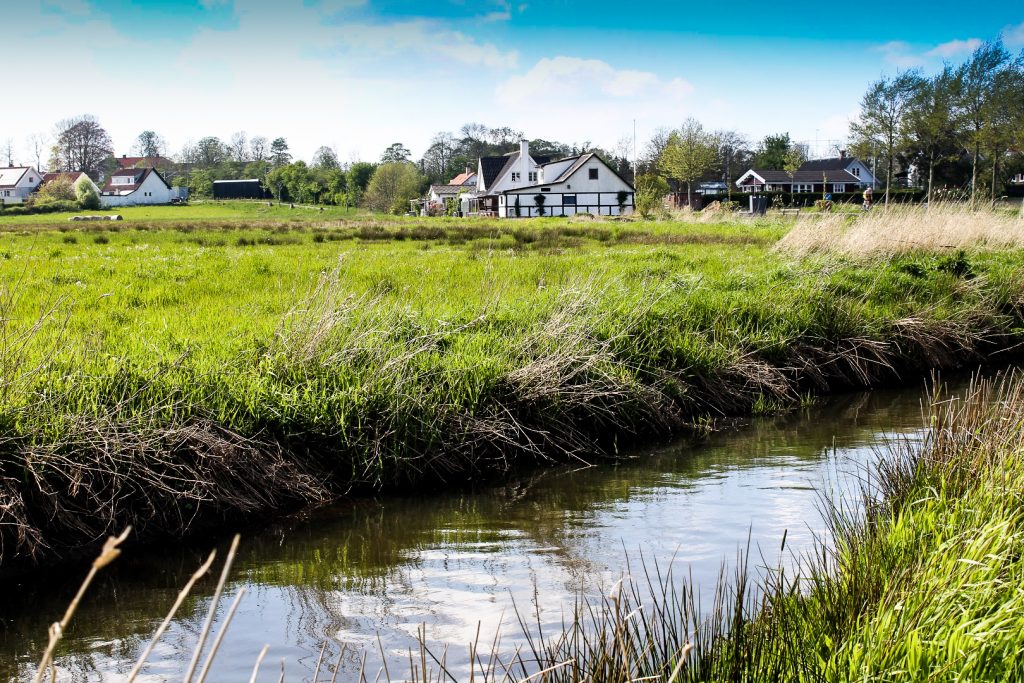
When I finally reached Assedrup, I took a little break on the paved road and waited for walkers and cyclists to pass by before continuing on the other side of the village. This section was wonderful as the terrain was easy and I was no longer on private land. There were no longer any cows or farmers that could scare me, although I was joined by a few deer and herons. For many kilometers, I walked through the untamed meadow, following the deep, glistening stream.
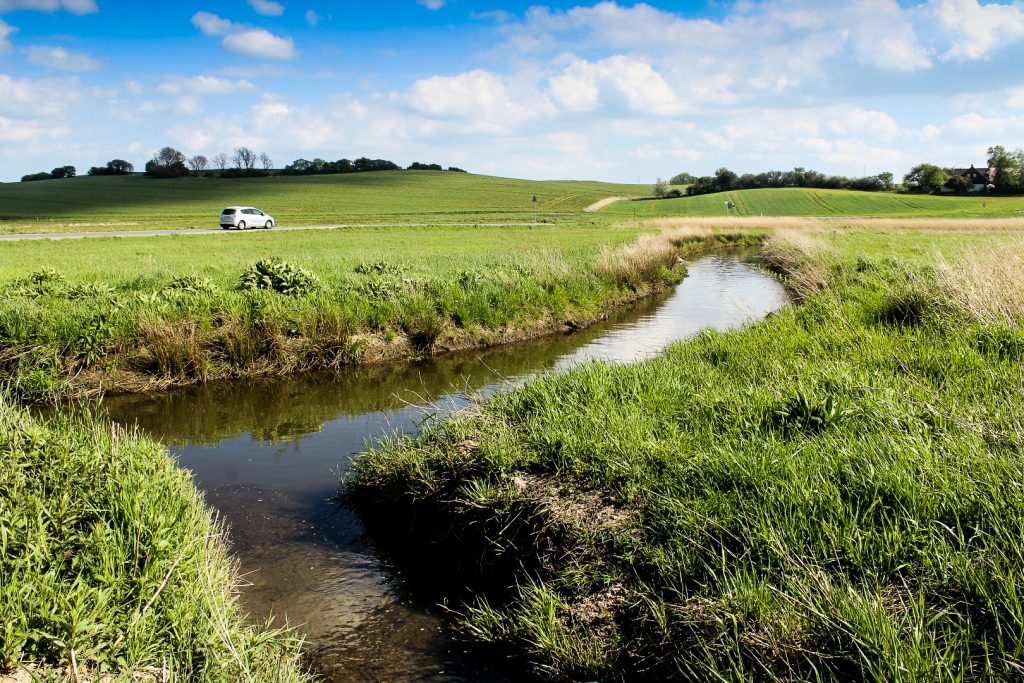
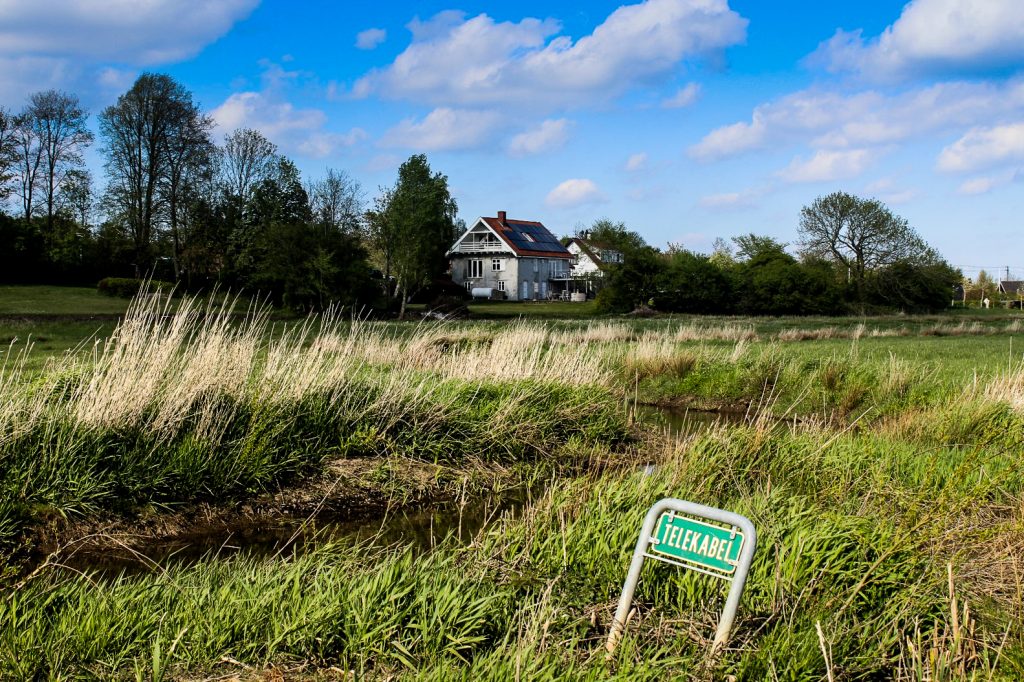
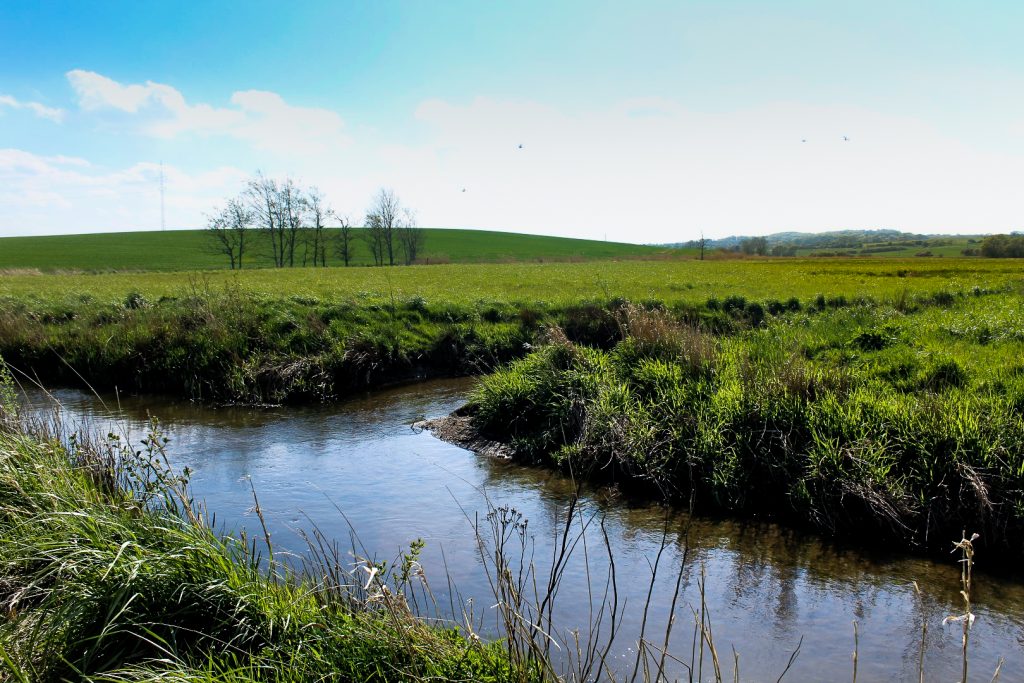
I had been strategic and crossed over to the left side of the stream, so I would avoid a few upcoming brooks. Thankfully, on this side, there was a bridge across Rævs Å where it met up with Odder Å, so my transition from one stream to another was as smooth as can be. I met up with Odder Å at 4.30 PM and said goodbye to Rævs Å, ready to begin the next leg of my trek!
Through meadows to the outskirts of Odder

The first section of the hike along Odder Å was easy and peaceful. I walked through high grass in a meadow that didn’t have any fences, so I assume it’s public land! It was lovely not having to worry about anything, although my feet were starting to get tired at this point, and my water bottles were almost empty. I needed to get to Odder soon, so I could have a rest, visit the bathroom and fill up my bottles.
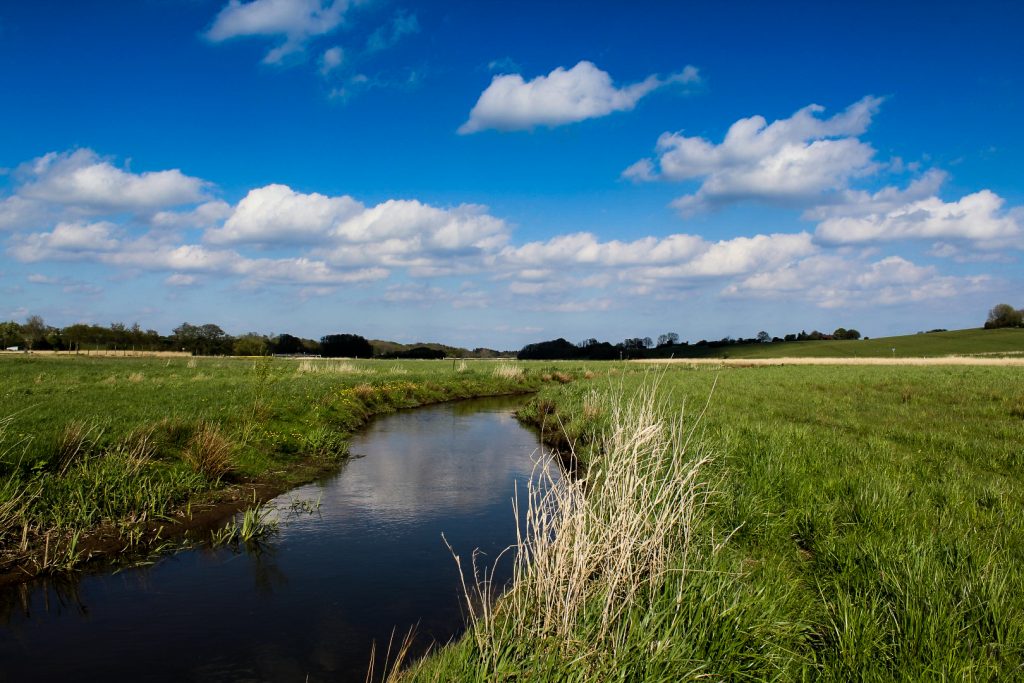
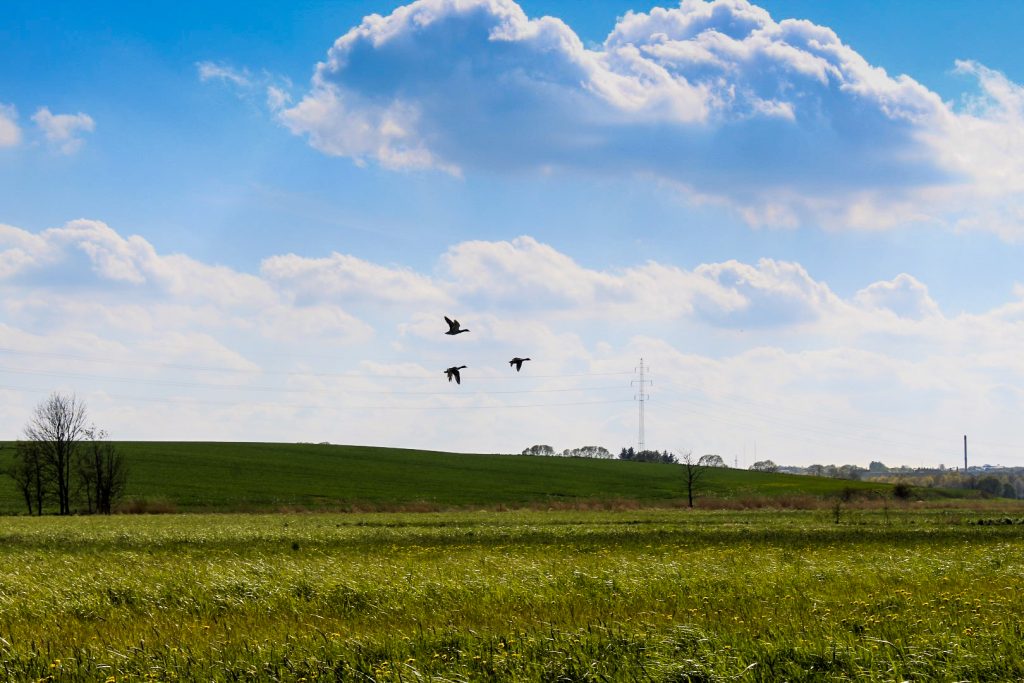
The stream ran alongside the railway all the way into the outskirts of Odder. Eventually, I met up with a little footpath, which took me past a large farm with grazing cows, through a tiny forest and to a gate that lead me into the town.



I was finally nearing the section of Odder Å which I know and love, where there is a paved path to follow and where I didn’t have to worry about sore feet, trespassing or cow attacks.
Through the centre of Odder to Rathlousdal

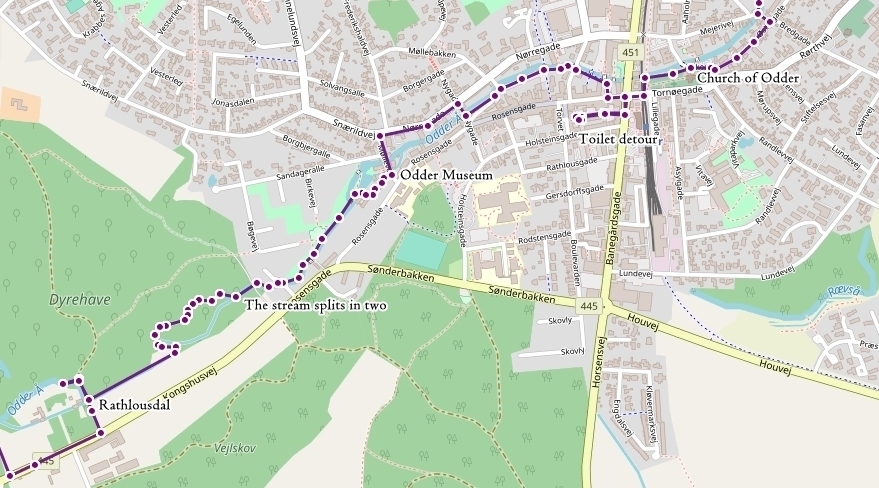
I reached Odder around 6 pm and went to the public toilet to fill up my bottles and do my business. I usually don’t mind peeing in nature, but I had been on open land and near farms for so long that someone definitely would’ve spotted me if I had done it… So the public toilet seemed like a much better option!
Odder proved more challenging than the meadow in terms of following the stream. THREE TIMES I had to take a small detour as I couldn’t possibly walk beside the stream as houses were built right up to it. I had been following the stream religiously since Norsminde Fjord, so I was a bit bummed about the detours, but they really couldn’t be helped.
I passed by the Church of Odder from the late 12th century and soon found myself in the very centre of Odder, where I sat down by the stream to write to my family and rest my feet. It had been a tough day, but I still had a lot more to come.

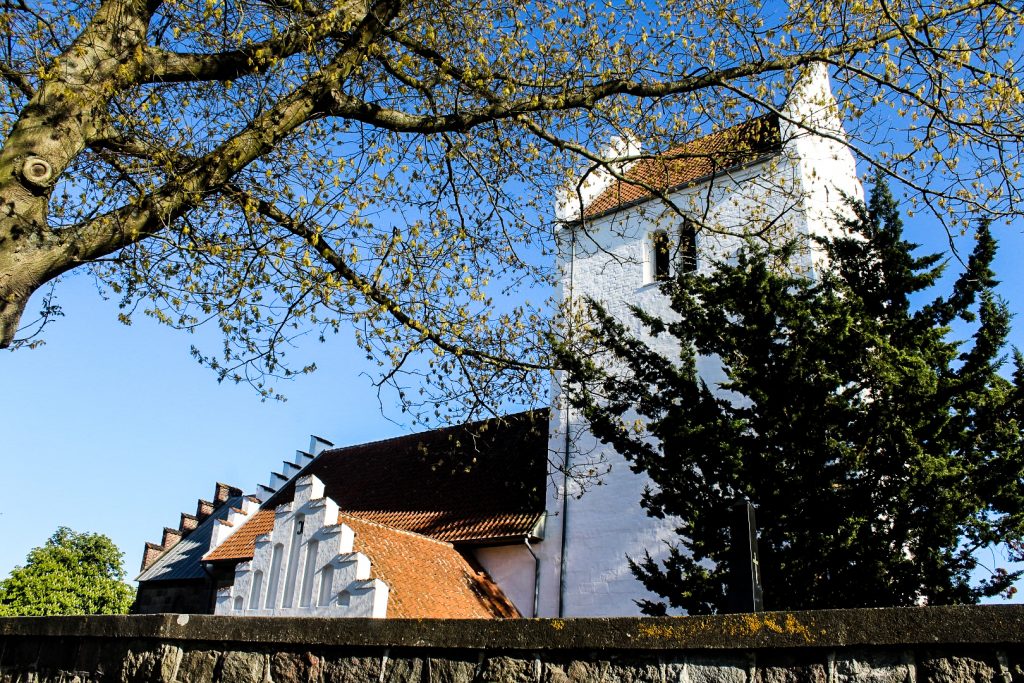

After my short break, I continued along the stream to Odder Museum, a local history museum which was established in 1928 by the old Odder Water and Steam Mill. The museum houses over 40,000 artifacts from Odder and the surrounding towns and villages (including Norsminde!), and is well worth a visit if you ever find yourself in Odder!
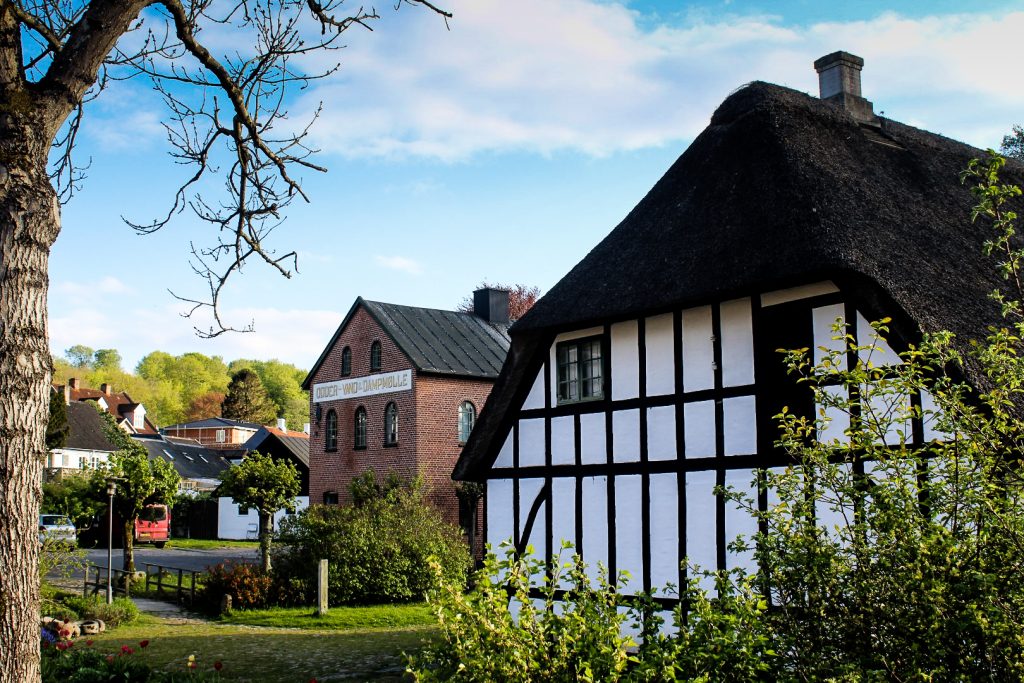
The next section of the stream is one I’ve walked many times before, and one I absolutely love. It’s not very long, but it flows behind gardens with little benches and chairs, past a playground and an old farm and into the Rathlousdal Forest, where the stream continues alongside a small footpath.
Unfortunately, I was unable to fully enjoy this lovely section as my feet were getting sore and I was starting to feel really tired. But I kept going with the prospect of soon finishing as, according to my maps.me, the finish line was less than an hour away. If only that had been true…

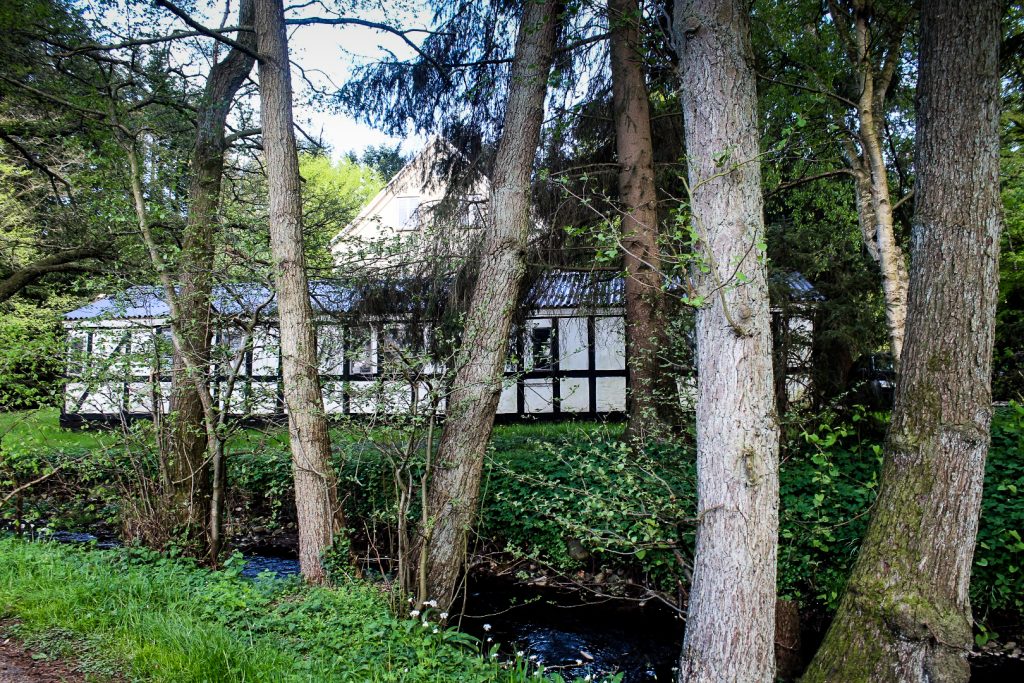

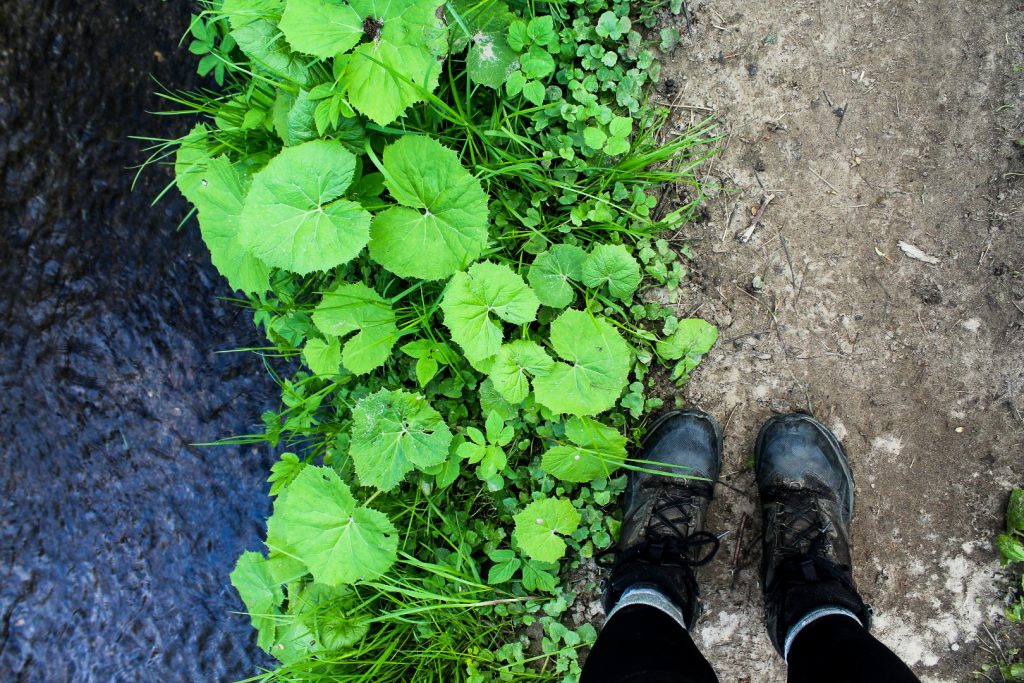

The path ended a few hundred meters before I got to the beautiful estate of Rathlousdal from the 16th century, but I had been able to make my way through the forest alongside the stream.
But once I got to Rathlousdal, it was no longer possible to follow the stream. It split in two, with one part going under the buildings of Rathlousdal and the other part going through a dense part of the forest with bramble bushes. I walked along the edge of the stream (literally – on the wall shown on picture #2), but I couldn’t get very far into the forest.
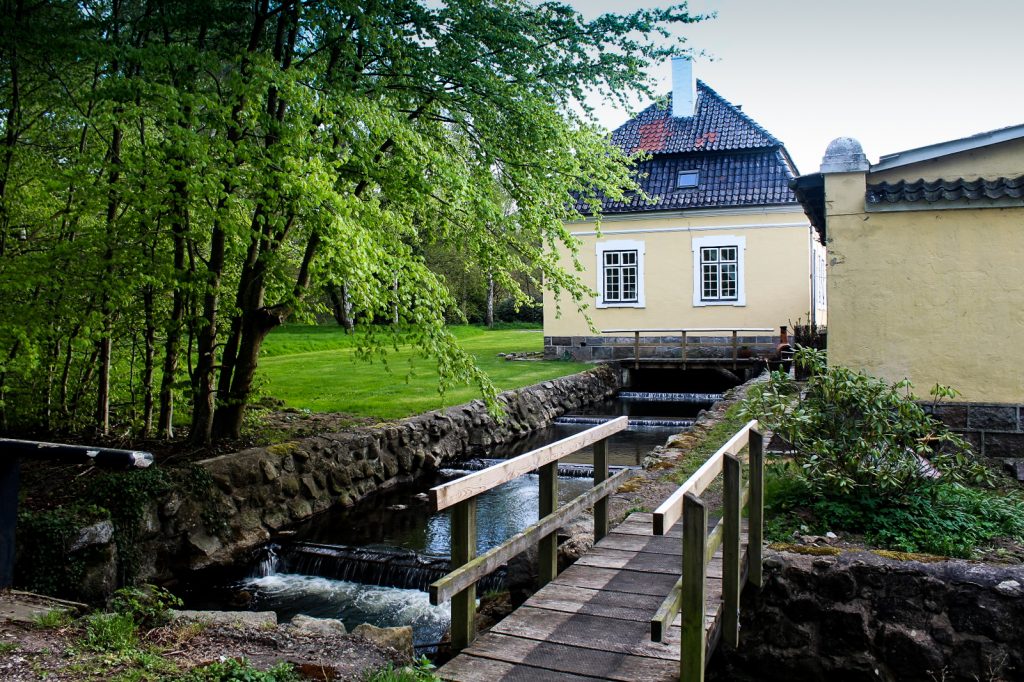
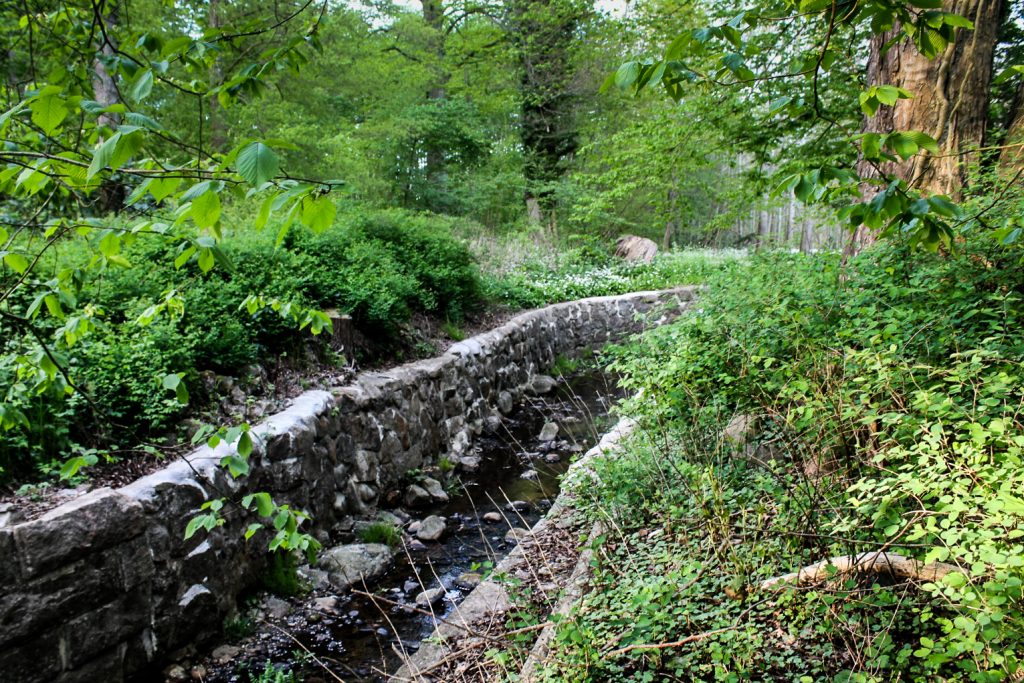
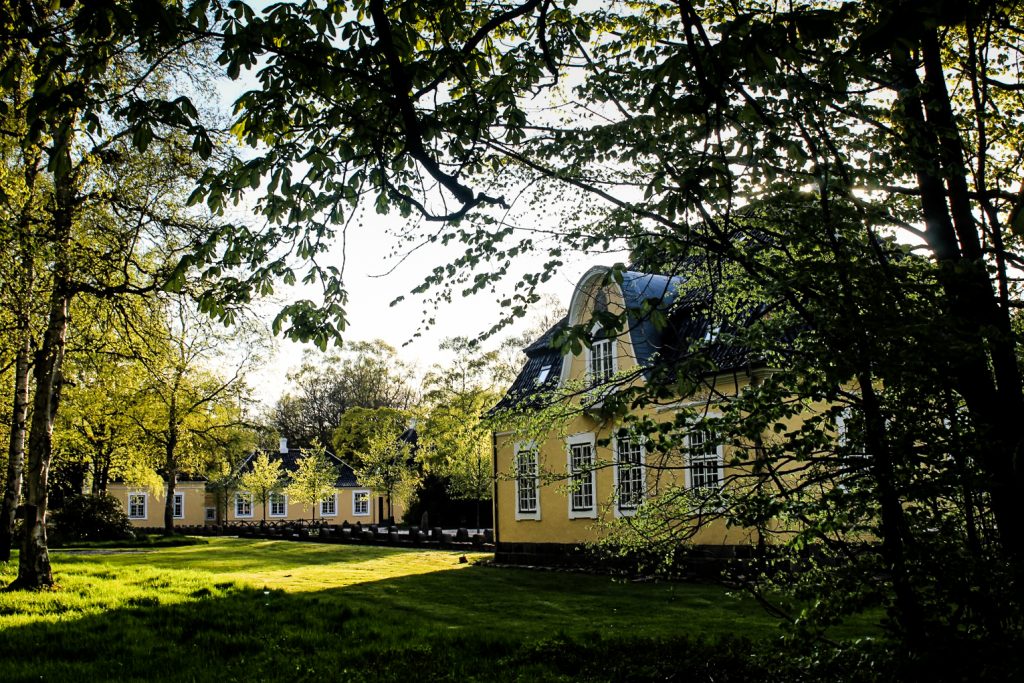
Even though the stream was shallow enough to cross, it didn’t make any difference as there was a garden belonging to the estate on the other side of it. So instead, I made a long detour past Rathlousdal and out to the road.
Through Fillerup to the fake spring
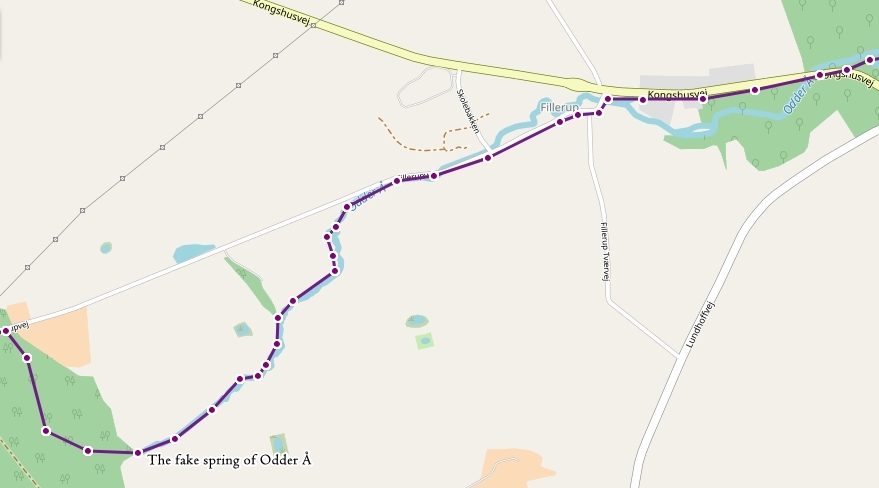
Once I was past the estate grounds, I followed a dirt track back into the forest where I met up with the stream again. There, I found an old ruin which must be a remnant from the 19th century wildlife park in the forest, which once housed bears, kangaroos and deer.
This part of the forest was much less dense, so I was able to walk alongside the stream until I got to the road, which crosses the stream. The forest on the other side of the road was very dense, but since the stream doesn’t stray too far from the road, I thought it was okay to continue along the road for a bit.
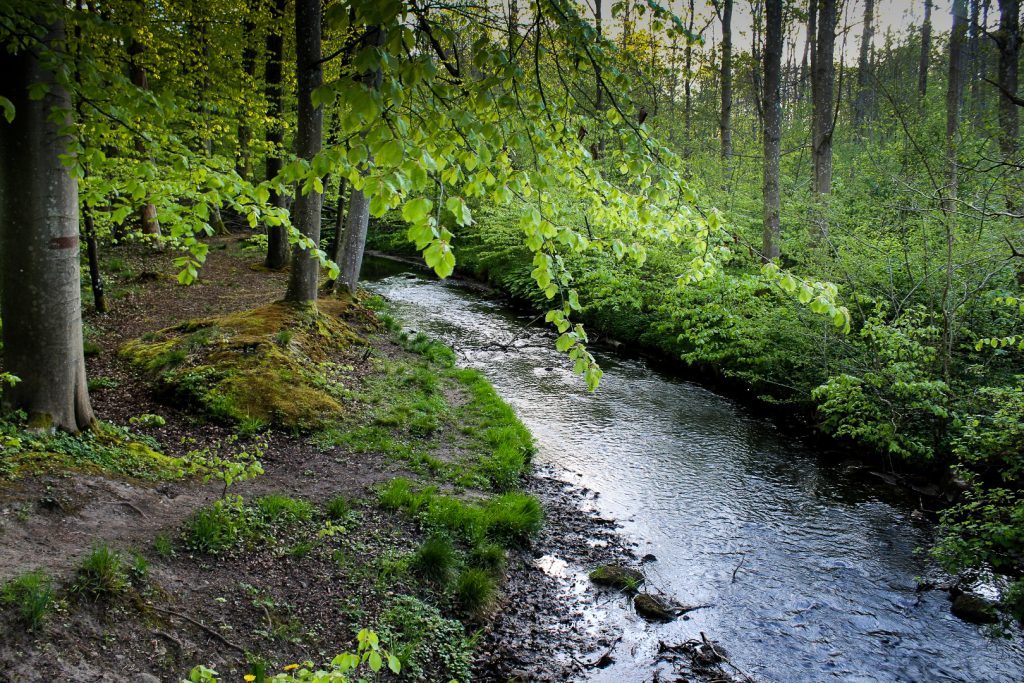


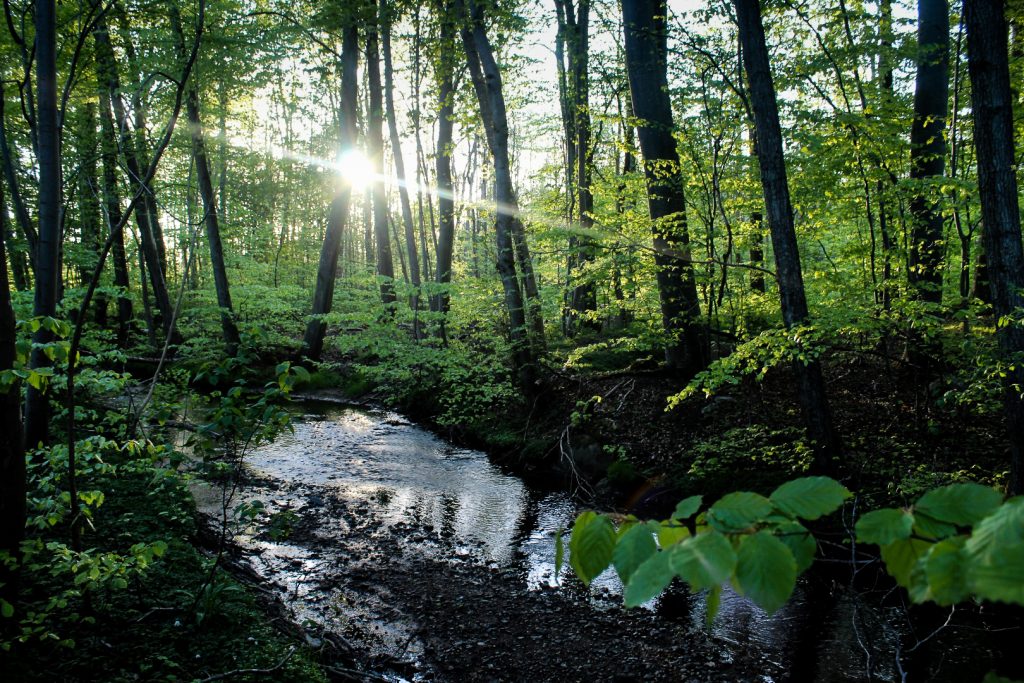
When I finally arrived in Fillerup, I was so relieved to soon be done with the trek (or so I thought). I found the stream again and followed it by walking down the street of Fillerupvej, where I could continuously see the stream to my right.
Some hundred meters along the road, the stream flowed beneath it and continued on its right. At this point, I went off-trail again, along the edges of fields, for what I thought was the last stretch of one kilometre before reaching the spring of the stream.
I was so tired and sore that the thought of a comfy bed almost had me calling my mum to pick me up once I reached the spring. But alas, the trek did not end where I thought it would. The stream continued through the forest, way past where my maps.me shows its spring. I looked on Google Maps and to my great disappointment and frustration, I saw that I still had another five or so kilometres to go before reaching the actual spring of the stream.
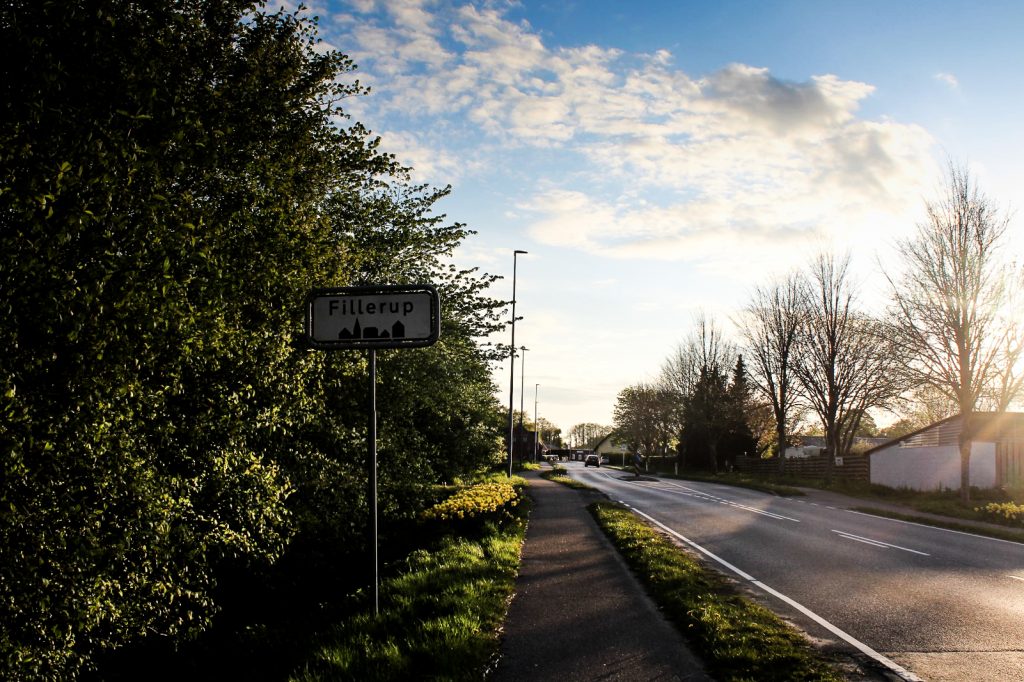
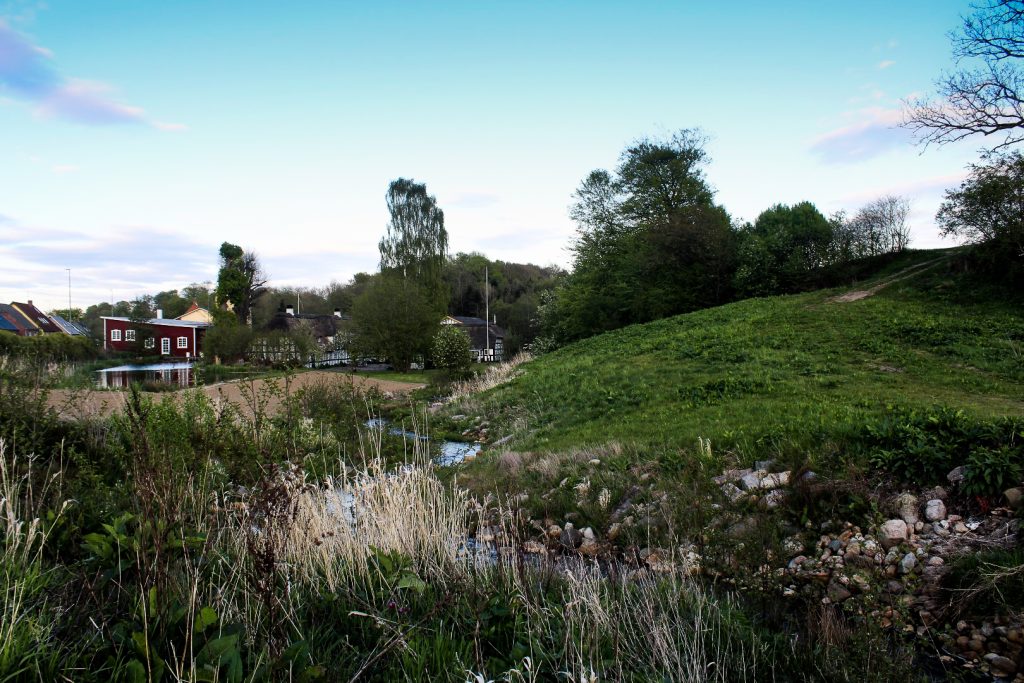

I continued following the stream while I considered my options. All I wanted was to eat and sleep. I thought about giving up, but I knew that I would regret that decision the next day. So I decided to finish what I’d started in the morning. Now I just needed to find a good and secluded camp spot – and fast. The sun had already set!
I was too close to a farm to camp where I was, and seeing how dense the forest was becoming, I decided to leave the stream to continue along a different section of Fillerupvej until I was out of the forest. Once I reached the edge of the forest, I looked down a field and spotted the stream.
I was quite far away from it, but I hurried along the edge of the field until I got to the stream and found a great spot to pitch my tent. I was at the edge of the forest, with fields on either side of me and no farms nearby. I felt safe there since I knew that nobody would disturb me. I have to admit that I’m always rather nervous when camping alone, although I’ve never had any issues and will continue to face my fear with vigilance.
I finished setting up the tent at 10.15 PM, just as it got too dark to see anything. I could finally eat my dinner, read the news and go to sleep in the heat of my sleeping bag.

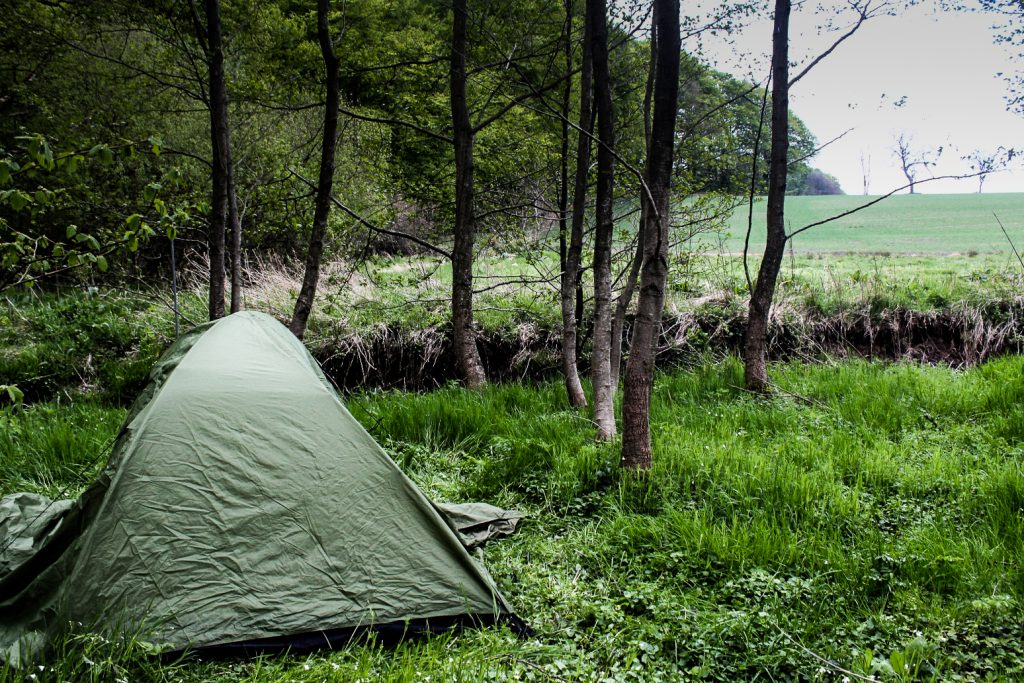
I woke up several times during the night and heard the many sounds of the forest. Once, I could hear several deer walking near my tent, and I woke up often to the beautiful sounds of the birds. That night reminded me of what camping is all about – being immersed in nature.
From the campsite through a dense forest

Despite not getting much sleep, I felt rested when I got up with the sun at 5.20 AM. I dawdled for a while, listened to the birds, ate my breakfast, got myself ready, removed snails from my outer tent and took the tent down. By 7 AM, I was ready to complete my goal of following Odder Å from one end to the other.
The first part of the morning trek took me along the edges of fields, before I reached a large forest, the last one on my journey. Two hares awoke from their sleep and ran off when they heard me coming along. This stretch was really nice with the forest on one side, a field with hares and deer on the other side and the stream and a grassy bit for me to walk on in the middle.
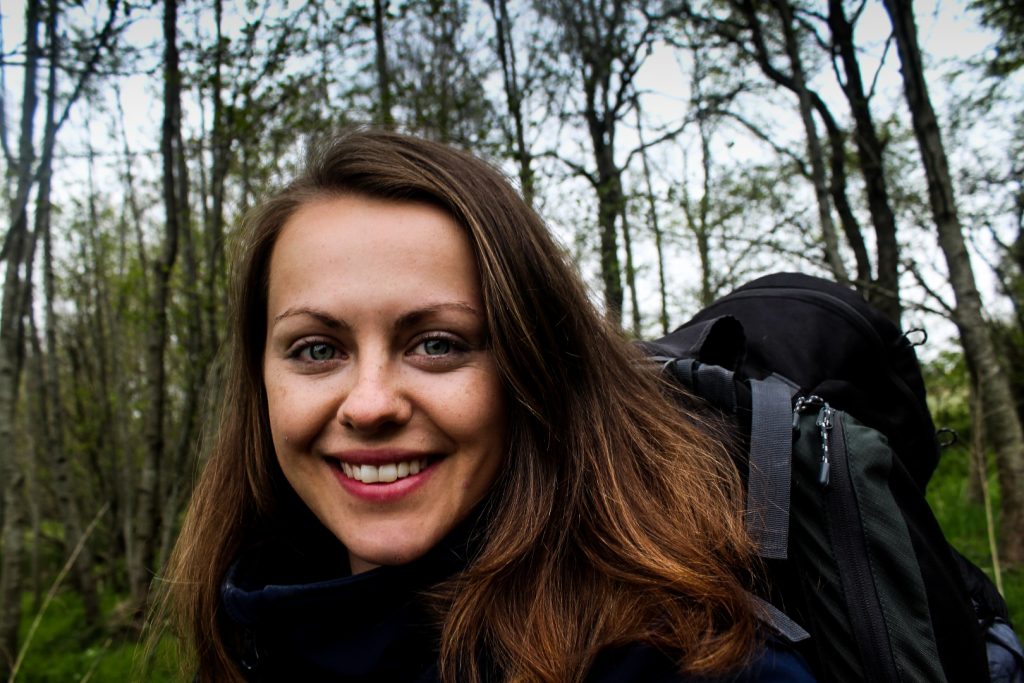
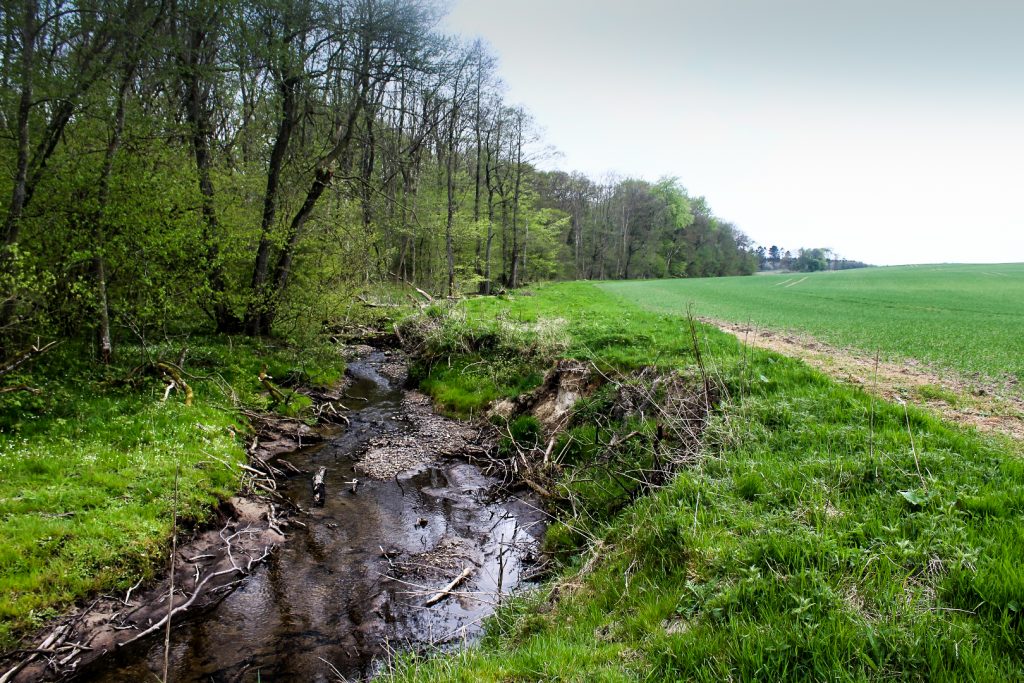
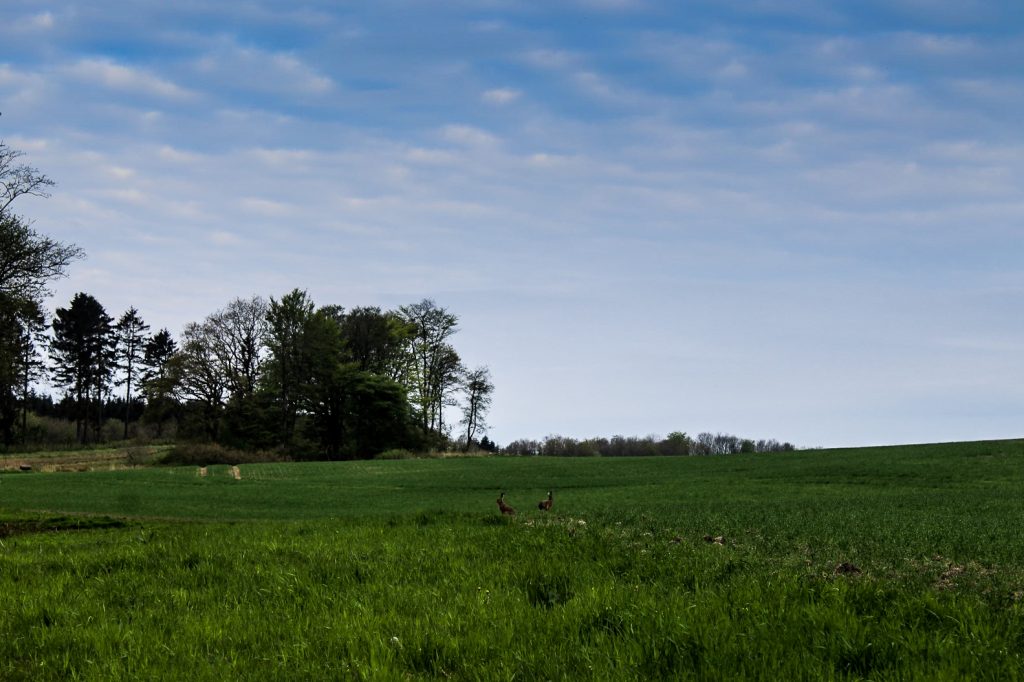
But after a while, the stream made a sharp turn into the dense forest. There were no roads or paths nearby, so I had no other choice than to try to make my way through. Dense, springy branches thwapped my face, pines stuck to my clothes, and I constantly had to crawl over logs.
Every once in a while, I crossed the shallow stream when it looked less dense on the other side. But it never really was.


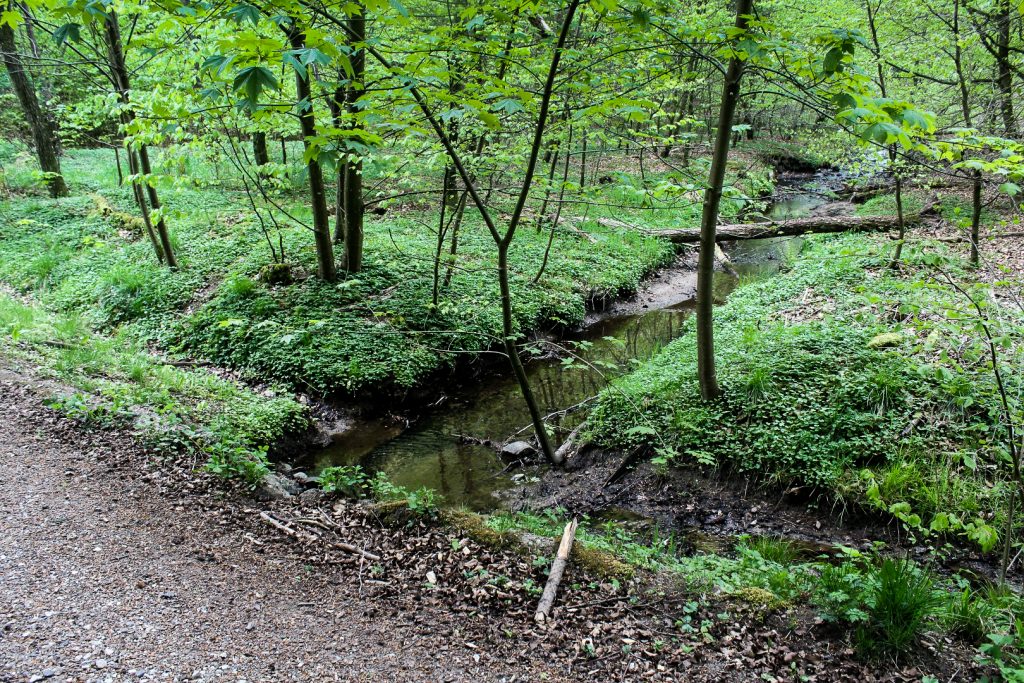
Eventually, I made my way through the dense forest. I don’t think I could’ve done this if I’d tried to complete the trek the day before, but with a bit of rest, I was able to push myself to continue. I sighed with relief when I was finally out of the forest and ready for the true last stretch of my trek – towards the spring of Odder Å.
Finding the spring – completing the trek!

The last stretch was short and sweet with fields on either side of the stream, and grassy bits for me to walk on without ruining any crops. I noticed how the stream got shallower as I neared its spring and suddenly, the water was gone. I’d reached its spring – finally!
I was overwhelmed with joy. It had only taken me an hour and 20 minutes to reach the spring from my camp spot, and with my dad on his way to pick me up, that comfy bed of mine didn’t seem so far away now. I DID IT!


The spring of Odder Å is in the middle of nowhere, between two fields near the village of Oldrup. Had I not followed the stream from its mouth, I don’t think I ever would’ve found it.
The last thing I had to do before ending my trek was to find my way onto a road so my dad could reach me. I spotted some farms in the distance and decided to head to the nearest one. I walked as fast as I could between the two fields until I reached the farm, which – thankfully – was surrounded by trees. Unnoticed, I walked along the side of the farm until I could finally place my feet on a road again.
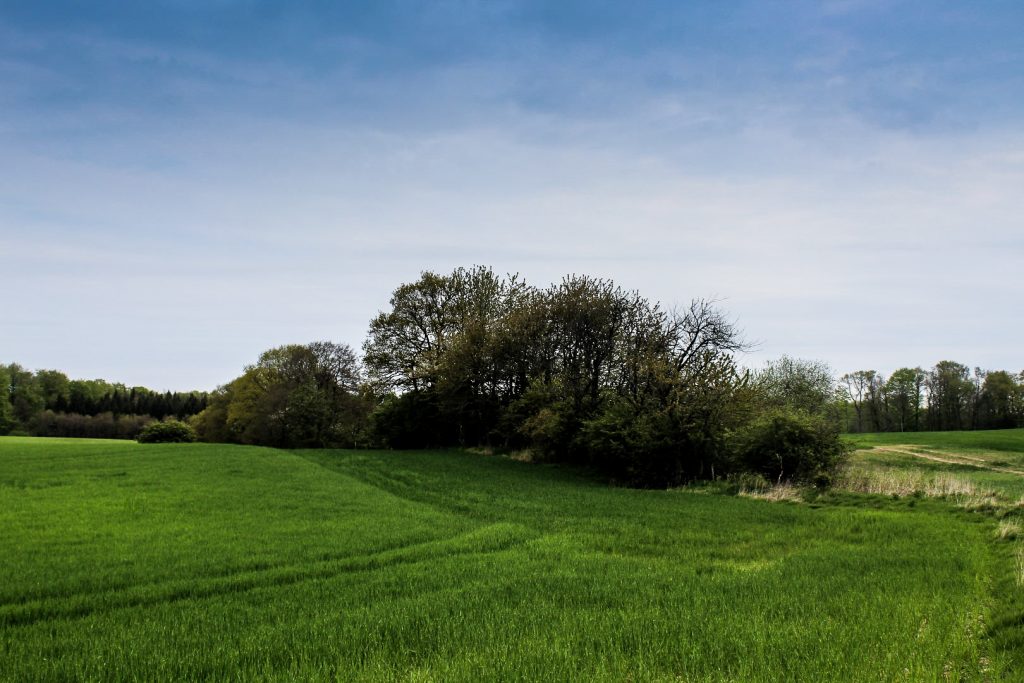

The aftermath
I was sore for several days after my trek. My feet looked completely dead, my legs felt heavy, I had 59 scratches on my arms and I had so many red spots from stinging nettles that I think I must be immune to them now. 30 kilometres of off-trail scrambling with a heavy backpack certainly took a toll on my body, but it had been worth it.
It was the greatest challenge I’ve ever completed alone. It was my first time going completely off-trail on a route I’d plotted out myself. I’m absolutely ecstatic that I managed to complete it, and I definitely feel like I can overcome more off-trail challenges in the future. Maybe I should find a different stream to follow next?
Leave a Comment
Pingback: Follow the old railway: Trekking 36 km from Odder to Horsens – Northtrotter on 21/05/2020
Pingback: My April-June 2020: Making changes in a Coronaworld – Northtrotter on 21/05/2020
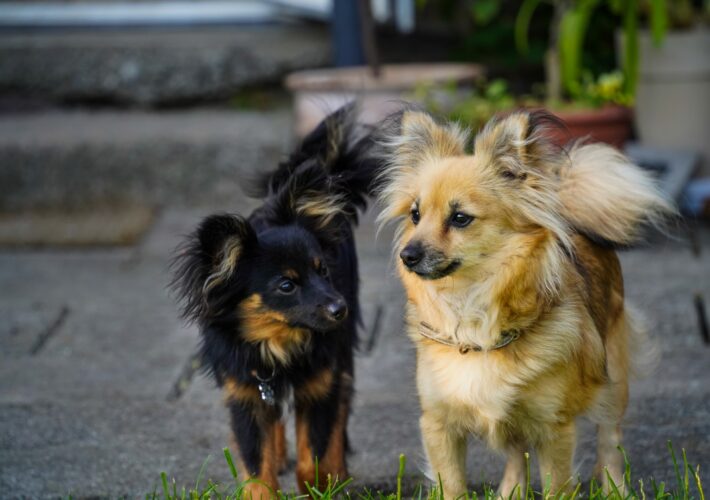
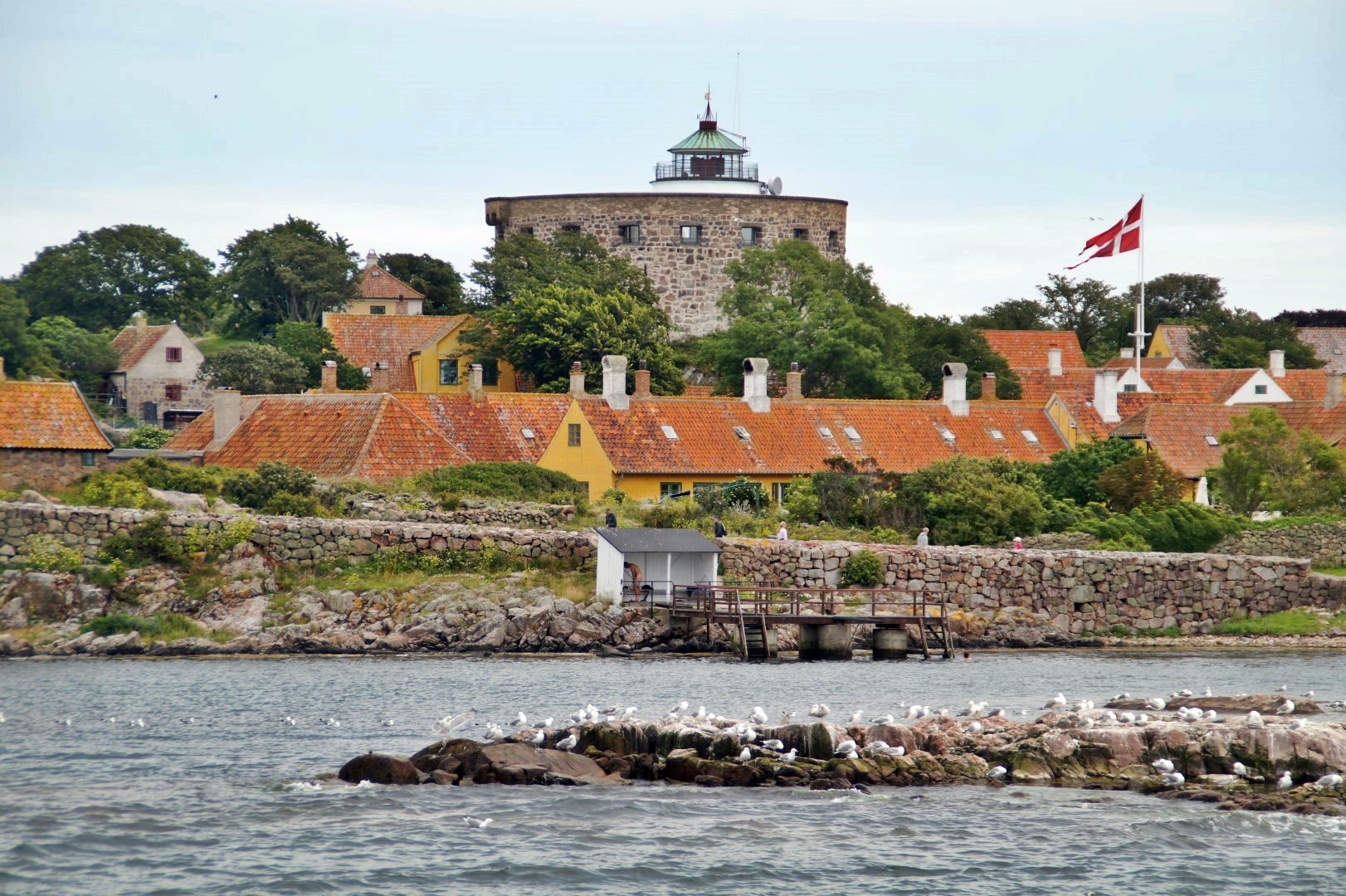
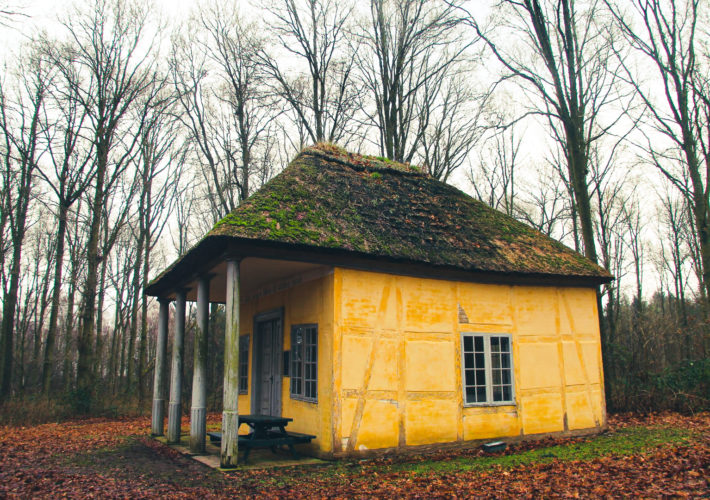

5 COMMENTS
Jette Høst Fausholt
3 years agoWhat a beautiful hike and beautiful photos! Well done!
Melissa Cherry Villumsen
3 years agoThank you, Jette! Odder sure has a lot of beautiful nature to offer!
Molly
4 years agoWonderful!